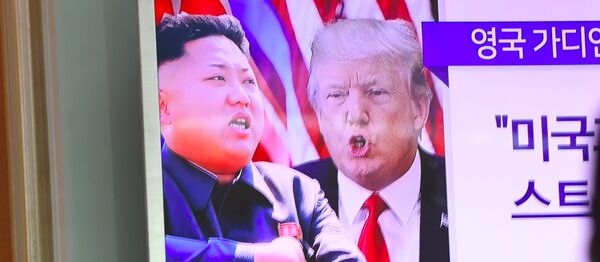Three Scenarios
Since 2011, North Korea has conducted 98 ballistic missile tests, and the program culminated with the first-time tests of an intercontinental ballistic missile (ICBM) on July 4 and July 28, 2017.
According to Zagurek’s analysis, North Korea currently has an arsenal of 20-25 nuclear warheads.
"Let us assume that North Korea has 25 operational nuclear weapons and that when under attack, it decides to launch its entire arsenal against both Seoul and Tokyo. The warhead yield ranges from 15 to 250 kilotons and are timed for airburst at optimal altitudes," he said in his report published on 38 North, a website dedicated to analyzing events concerning North Korea.
The second possible scenario is a missile test that has the payload impact area too close to US bases in Guam. In this case, according to the analysis, Washington would be quick to react with force, including attempts to shoot down the missiles.
Finally, the third scenario could be attacking North Korean missile and nuclear related sites and deployment areas.
"The North Korean leadership might perceive such an attack as an effort to remove the Kim family from power and, as a result, could retaliate with nuclear weapons as a last gasp reaction before annihilation," Zagurek wrote.
Millions of Fatalities
Pyongyang’s nuclear arsenal is too small and incapable of selective strikes on military bases, airfields and other facilities. As a result, in the event an open conflict, Pyongyang would have only one option – to launch the entire arsenal on the densely-populated capitals of its US-allied neighbors, South Korea and Japan.
Zagurek calculated the consequences of hypothetical North Korean strikes on Seoul (24.1 million, population density – 8,800 per sq. km) and Tokyo (38 million, population density – 4,440 per sq. km) for seven scenarios, depending on the yields of the warheads.
The expert also pointed out that not all of the 25 North Korean warheads would be able to reach the targeted areas.
Among the scenarios calculated by the expert are a strike on one of the cities and a strike at both cities at the time as well as a strike with warheads with minimal or maximum yields.
With a 20 percent probability of detonation, a strike with missiles of varied yields would immediately kill some 600,000 in both cities, with nearly two million injured. The same scenario according to the analysis, but with an 80 percent probability of detonation, would result in 2.1 million fatalities and 7.5 million injured.
Muscle Flexing
No matter how precise these estimates are the real possibility of nuclear conflict on the Korean Peninsula is next to none, according to experts. Despite their warmongering rhetoric, both US President Donald Trump and North Korean leader Kim Jong-un are unlikely to take actions that could unleash global annihilation.
"Time is now playing into the hands of the North Korean leader. The more various ballistic missiles Pyongyang has the more difficult it will be for Washington to impose a military solution. In fact, the US and its persistent threats are to blame," Russian military expert Mikhail Khodarenok told Sputnik.
"Once Pyongyang has obtained a capable nuclear arsenal the North Korean leadership will feel relatively safe and stop fueling tensions in a unilateral manner," the expert suggested.






